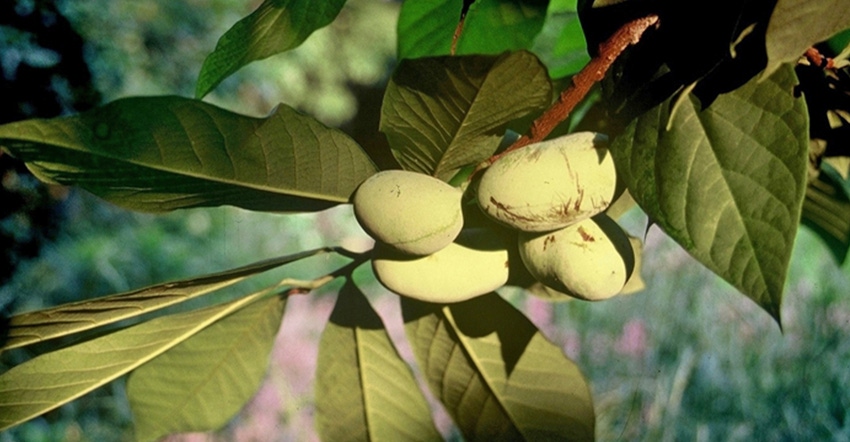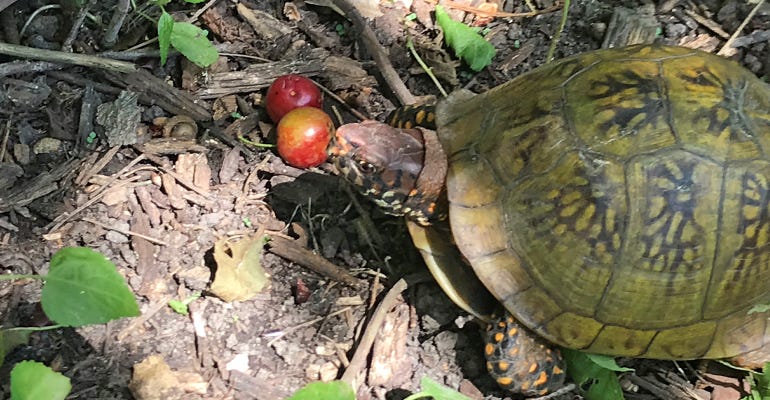September 19, 2019

When it’s a good year for edible fruits in the garden, grazers show up, lips smacking. This year was no exception. It happened to be a good year for serviceberries, gooseberries, golden currants, elderberries, chokeberries, persimmons, pawpaws and plums.
Thanks to this year’s unusual steady rains, there has been an abundance of native fruits, and all are wonderful to eat. Here are a five ways to incorporate them into your meal plan:
1. Goose plums. Pick plums right off the tree. They make an excellent sour plum sauce to spoon over vanilla ice cream and pancakes. When processing plums, simmer the fruits in water for 10 minutes to soften, reserving the water, and then run fruits through the food mill. I make the plum sauce by adding sugar to taste and some of the reserve water to get the right consistency, like applesauce.

TASTY TREAT: A box turtle at Whitmire Wildflower Garden at Shaw Nature Reserve eats fallen goose plums. These can be gathered up to create a sour plum sauce.

2. Pawpaws. Before raccoons can take all of the pawpaws, gather some up. I managed to collect enough fruit for a batch or two of pawpaw ice cream.
3. Serviceberries. Serviceberries are best eaten fresh off the tree. Usually, there are enough for birds and people to share. Not so for gooseberries and currants. The birds usually devour them. Cover them with bird netting while the fruits are plump, but still green, and then harvest the fruits when they ripen soft and dark. They both are sharply tart, but with sugar, they make a nice jelly. Or, try bottling them whole to serve later over shortcake. Black chokeberry is a prolific fruiter and makes a decent jam, although it has a slightly unpleasant aftertaste.
4. Elderberries. Elderberry fruit is inedible raw, but ferments into a delicious wine, if you have the patience for this sort of thing. I’ve made three batches but only had success once. Elderberry flowers, on the other hand, are relatively easy to turn into cordial or syrup that can be added to ice-cold sparkling water or bubbly wine for a tasty summertime refresher. Syrup and juice also can be made from the juice of the berries. To learn how, check out "River Cottage Handbook #2" on preserves by Pam Corbin.

SEPARATION PROCESS: A Foley’s food mill makes short work of separating pulp from seeds and skins. Use it on fresh persimmons and pawpaws and freeze the pulp in one-cup measures. It lasts frozen for three years.

5. Persimmons. Persimmons can be transformed into pudding, which is really just a moist cake that is slow-baked in a steam bath. Persimmons must be harvested when they fall to the ground. Any sooner and you will regret putting one to your lips. Some persimmons ripen in early September, well before frost, while others ripen in October after first frost. To learn how to make this mouth-watering dessert, check out "Fields of Greens," a vegetarian cookbook by Annie Somerville. If you have never eaten a baked persimmon concoction that you truly enjoyed, you will fall in love with this one. Bon appetit!
So, before the raccoons, birds and squirrels gather up all the native fruits, head out this fall and grab your own supply. It makes for a wonderful fall treat.
Horticulturist Scott Woodbury is the curator of the Whitmire Wildflower Garden at Shaw Nature Reserve in Gray Summit, Mo. He also is an adviser to the Missouri Prairie Foundation’s Grow Native! program.
About the Author(s)
You May Also Like




